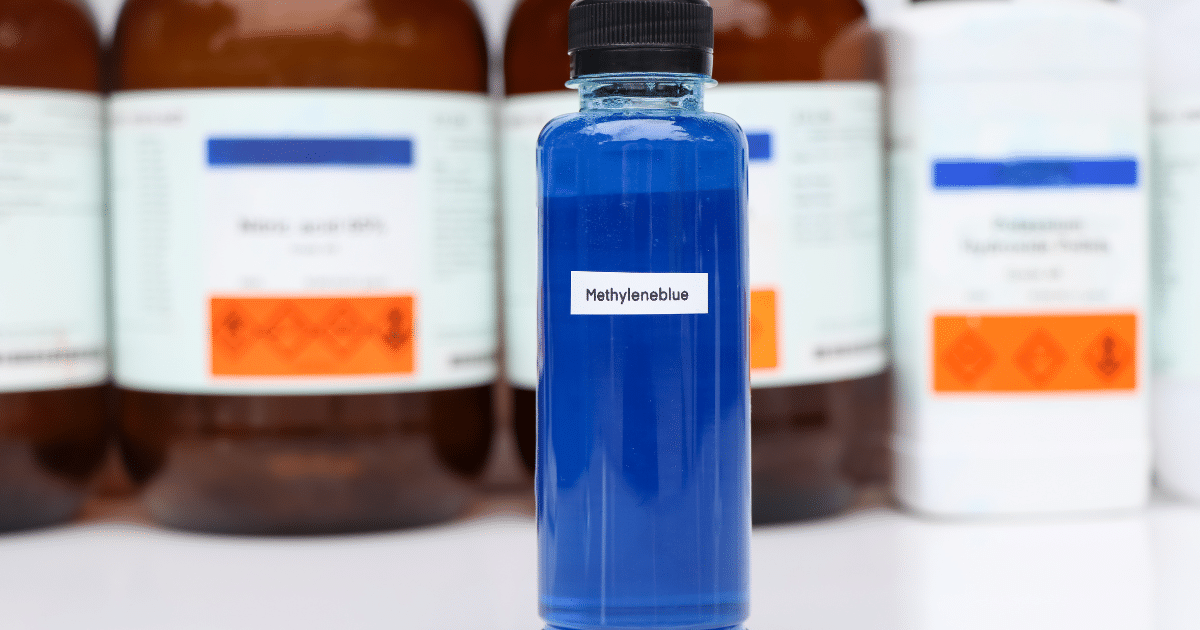Chemistry for Health: The Healing Potential of Methylene Blue
Have you ever wondered how the vibrant blue color of a new pair of jeans could be linked to your health? In an age where wellness is paramount, it’s no surprise that people are constantly on the lookout for new ways (like the use of Methylene Blue) to combat illnesses and enhance their wellbeing.
Yet, often, some solutions lie in the most unexpected substances. Methylene Blue might just be one such hidden gem with a spectrum of healing possibilities.
This intriguing compound, known as methylthioninium chloride, isn’t just any dye. It has been making waves for its potential role in treating conditions ranging from methemoglobinemia to certain neurodegenerative diseases and even malaria.
As we dive into this topic, you’ll discover how chemistry isn’t only about bubbling potions but can present real avenues for health breakthroughs. Stay tuned as we unravel the story behind Methylene Blue—your body might thank you for it!

Disclaimer: This article is for informational purposes only and is not meant to treat or diagnose any condition. While Methylene Blue is used to help certain conditions, it is recommended that you speak with your doctor before using Methylene Blue for the treatment of any condition. The use of Methylene Blue in the treatment should only be done under the supervision of a healthcare professional.
Table of Contents
Key Takeaways
- Methylene Blue is a versatile compound with medical applications including the treatment of methemoglobinemia, cyanide poisoning, shock symptoms, and ifosfamide-induced encephalopathy.
- Beyond medicine, it serves an essential role in the food industry for testing milk freshness due to its ability to measure redox potential and ensure consumer safety.
- Research suggests promising uses of Methylene Blue in treating Alzheimer’s disease, bipolar disorder, malaria, and certain cancers by exploiting its antioxidant properties and cellular protective effects.
- While beneficial, it also carries risks such as potential side effects like hemolytic anemia or serotonin syndrome; specific contraindications must be considered before use.
- Drug interactions are important considerations when using Methylene Blue—consultation with healthcare professionals is crucial to prevent adverse reactions or reduced drug efficacy.
What is Methylene Blue?
Methylene Blue is a synthetic agent with various medical and industrial uses. In medicine, methylthioninium chloride is used to treat methemoglobinemia, cyanide poisoning, and shock. Additionally, it is utilized in the food industry for tests like the freshness test for milk.

Here are two high-quality versions of the supplement:
- Compass Laboratory USP-Grade Methylthioninium Chloride Liquid
- Biopharm Methylene Blue Pharmaceutical Grade
- Earth Harmony Methylene Blue Pharmaceutical Grade
Uses in medicine (methemoglobinemia, cyanide poisoning, shock)
Methylene Blue dye plays a vital role in emergency medicine and has multiple healing properties. This versatile compound is a lifesaver in several critical conditions.
· Treats methemoglobinemia: Health care professionals have demonstrated that Methylene Blue has been used to treat methemoglobinemia, which occurs when iron in the blood transforms into an abnormal form that can’t carry oxygen effectively. The drug works by converting ferric iron back to its oxygen-carrying ferrous state, restoring the red blood cells’ ability to carry oxygen.
· Counters cyanide poisoning: In cases of cyanide poisoning, where cells are starved of oxygen despite its abundance in the bloodstream, Methylene Blue is used as this compound ensures survival by acting as an antidote. Methylthioninium chloride does this through a complex mechanism involving the electron transport chain and mitochondrial function, which helps cells utilize oxygen once again.
· Mitigates shock symptoms: It reduces shock symptoms. During severe medical shock where blood pressure drops dangerously low, a Methylene Blue injection (mb injection) can offer life-saving vasoconstrictive properties. This action helps raise blood pressure by narrowing the blood vessels and improving circulation.
· Assists in ifosfamide-induced encephalopathy treatment: Ifosfamide, a chemotherapy agent, can cause encephalopathy or brain dysfunction. Administration of Methylene Blue has shown effectiveness in reversing this serious neurotoxic effect without compromising cancer treatment efficacy.
Use of Methylene Blue in the food industry (freshness test for milk)
In the bustling world of food safety, Methylene Blue plays a unique role in ensuring that milk stays fresh. This versatile dye doubles as a freshness test for milk by measuring the level of reduction oxidation (redox) potential.
When added to milk, it reacts with oxygen present and changes color accordingly; if the milk is fresh, it maintains its blue hue longer because reduced levels of bacteria are present to consume oxygen.
This inexpensive assay is a godsend for dairy farmers and processors who need quick results. It provides them an easy way to monitor their product’s quality without sophisticated equipment.
Related Article: How to Help Boost Serotonin Levels in Your Body Naturally
Consumers also benefit from this method as they can enjoy fresher, safer milk on their tables. Methylene Blue thus bridges the gap between industry-grade quality assurance and everyday consumer health needs seamlessly.
Potential Health Benefits of Methylene Blue
Methylene Blue has shown potential in treating methemoglobinemia, Alzheimer’s disease, bipolar disorder, and even malaria. Its antioxidant properties and neuroprotective effects make methylthioninium chloride an intriguing subject for further research into its potential health benefits.
1. Treatment for methemoglobinemia
Treating methemoglobinemia often involves the use of Methylene Blue as a key agent. This condition, where abnormal amounts of methemoglobin build up in the blood, reduces its ability to carry oxygen effectively.
Methylthioninium chloride enters the equation as an effective antidote due to its ability to act as both an antioxidant and reducing agent. Through a biochemical reaction, it helps convert the excessive methemoglobin back into hemoglobin, allowing normal oxygen transport once more.
Administering Methylene Blue for this purpose is typically done intravenously under medical supervision, especially since correct dosages need careful calculation based on individual patient factors such as age and weight.
It’s important to note that while effective for most people with acquired or drug-induced forms of the condition, those with G6PD deficiency require alternative treatments due to potential adverse effects.
2. Potential for treating Alzheimer’s disease and bipolar disorder
Methylene Blue holds promise in the potential treatment of Alzheimer’s disease and bipolar disorder. Studies suggest that methylthioninium chloride exhibits neuroprotective properties, which may have a positive impact on cognitive function and mood regulation.
The antioxidant properties of Methylene Blue show potential in combating oxidative stress, which is associated with Alzheimer’s disease. Additionally, research indicates that it may help regulate serotonin levels, making it a promising candidate for managing symptoms of bipolar disorder.
Related Article: 5 Niacinamide Health Benefits Backed By Research
Moreover, the antimalarial properties of Methylene Blue could potentially benefit individuals with Alzheimer’s disease by addressing neuroinflammation, while also aiding in reducing amyloid-beta protein buildup—commonly associated with the condition.
3. Potential in malaria treatment
Research suggests that Methylene Blue shows promise in the treatment of malaria, with potential benefits in combating this infectious disease. Studies have indicated that methylthioninium chloride exhibits antimalarial properties and may be effective against the malaria parasite.
This cationic colorant has been shown to interfere with the growth and development of Plasmodium, the causative agent of malaria, offering a possible avenue for future antimalarial treatments.
Methylene Blue’s ability to disrupt the lifecycle of the malaria parasite presents an exciting prospect for addressing this global health challenge. Its potent antimalarial properties could contribute to advancing treatment options and possibly reducing the burden of malaria on affected populations.
4. Potential in cancer treatment
Methylene Blue exhibits potential in cancer treatment by inhibiting the growth of certain types of cancer cells. Studies have shown that methylthioninium chloride can selectively target and inhibit the proliferation of cancer cells while sparing healthy cells.
Related Article: How Can Cordyceps Help Improve Your Health?
This promising property makes it a subject of ongoing research for its potential use as an adjunct therapy in the treatment of various cancers, including breast, prostate, and ovarian cancers.
Additionally, it has demonstrated antioxidant properties that may help reduce oxidative stress and cellular damage associated with cancer development. These findings open up avenues for further exploration into the therapeutic role of Methylene Blue in combating cancer progression.
Risks and Contraindications
Potential risks and contraindications of Methylene Blue include adverse effects, contraindications for use, and potential drug interactions that users should be aware of before considering its use.
To learn more about the potential health benefits and risks of using Methylene Blue for health purposes, keep reading the article!
Adverse effects related to Methylene Blue
Methylene Blue can cause side effects in some individuals, including:
1. Hemolytic anemia: Methylene Blue may lead to the breakdown of red blood cells, causing a decrease in hemoglobin levels and potentially resulting in anemia. This condition can be particularly concerning for individuals with glucose-6-phosphate dehydrogenase deficiency.
2. Serotonin syndrome: Excessive use of methylthioninium chloride can lead to serotonin toxicity, which may result in symptoms such as agitation, confusion, rapid heart rate, and high blood pressure. It is important to use this compound cautiously, especially when combined with certain medications that affect serotonin levels.
3. Neurotoxicity: In some cases, Methylene Blue has been associated with neurotoxic effects, which can manifest as adverse effects on the nervous system and cognitive function. This highlights the importance of carefully monitoring its use and dosage.
4. Drug interactions: Due to its potential to interact with various medications, it is crucial for individuals to consult healthcare professionals before using methylthioninium chloride alongside other drugs. Specific caution should be exercised when combining it with selective serotonin reuptake inhibitors (SSRIs) or monoamine oxidase inhibitors.
5. Gastrointestinal disturbances: Some users may experience gastrointestinal side effects such as nausea, vomiting, or diarrhea after taking Methylene Blue.
6. Skin reactions: Allergic skin reactions and dermatitis are among the potential adverse effects associated with topical application of methylthioninium chloride.
7. Other potential side effects: Additional adverse reactions may include the development of reactive oxygen species due to the redox activity of Methylene Blue and rare instances of methemoglobinemia exacerbation despite its intended role in treating this condition.
Contraindications for use of Methylene Blue
Although Methylene Blue shows promise as a versatile compound with potential health benefits, there are important contraindications for its use. It’s crucial to consider the following factors before incorporating methylthioninium chloride into your health regime:
1. Interaction with certain medications: Methylene Blue can interact with specific medications, such as serotonin reuptake inhibitors like venlafaxine, potentially leading to fatal serotonin toxicity.
2. Pre-existing medical conditions: Individuals with G6PD deficiency should avoid methylthioninium chloride due to the risk of hemolytic anemia.
3. Potential for adverse effects: Methylene Blue administration may result in side effects such as methemoglobinemia, which can be severe and life-threatening in certain individuals.
4. Dosage considerations: The appropriate dosage of methylthioninium chloride for human consumption is still under investigation, and excessive doses could lead to harmful effects on health.
5. Avoidance during pregnancy and breastfeeding: Due to limited research on the effects of Methylene Blue during pregnancy and breastfeeding, it is advisable to avoid its use during these periods.
6. Allergic reactions: Individuals with known allergies to dyes or phenothiazines should exercise caution when considering Methylene Blue supplementation.
Potential drug interactions with the use of Methylene Blue
Methylene Blue may interact with certain drugs, leading to adverse effects or reduced efficacy. It’s crucial to be aware of potential interactions when using this compound. Here are some noteworthy drug interactions to consider:
1. Methylene Blue should not be used with serotonergic psychiatric medications due to the risk of serotonin syndrome, a potentially life-threatening condition.
2. Combining methylthioninium chloride with certain antidepressants, such as SSRIs or SNRIs, can lead to increased serotonin levels and elevate the risk of serotonin syndrome.
3. Avoid concomitant use of Methylene Blue with monoamine oxidase inhibitors (MAOIs) as it can lead to a dangerous increase in blood pressure.
4. When taking medications that affect liver enzymes, such as CYP3A4 inhibitors or inducers, it’s important to consider potential alterations in Methylene Blue metabolism and effects.
5. Use caution when combining methylthioninium chloride with medications that affect the cardiovascular system, as it may potentiate the effects of these drugs and lead to adverse outcomes.
6. Simultaneous use of Methylene Blue and certain anti-hypertensive medications might result in an increased risk of hypotension or altered blood pressure regulation.
7. Combining methylthioninium chloride with specific anesthetics or sedatives may lead to additive central nervous system depression and respiratory depression, necessitating careful monitoring.
8. Always consult healthcare professionals before using Methylene Blue alongside any prescribed or over-the-counter medications to mitigate potential drug interactions and ensure safe usage.
Methylene Blue Can Improve Your Health
To wrap this up, the healing potential of Methylene Blue offers a range of promising benefits for health and longevity enthusiasts. By summarizing its versatile applications in medicine and the food industry, we can appreciate its practicality and efficiency.
Related Article: Do Healing Crystals and Rocks Really Work?
Highlighting the importance of this compound emphasizes how it could lead to significant improvements in various health conditions. Further reading on ongoing studies about suitable dosages and side effects can provide additional guidance if you’re interested in learning even more.
Ultimately, exploring the potential of Methylene Blue presents an exciting opportunity to delve deeper into its multifaceted healing properties.
FAQs
Methylene Blue is a blue dye that doctors use to treat conditions like methemoglobinemia, where it can convert the affected hemoglobin back to its normal state.
When injected, Methylene Blue targets the mitochondrion and helps cells use oxygen more efficiently; plus, it acts against certain types of poisoning by restoring enzyme activity that’s key for healthy blood.
Yes, some people might experience side effects from Methylene Blue; these may include changes in color vision or nausea but vary from person to person.
No, you should only take Methylene Blue under medical supervision since it’s a potent medicinal agent and not something found in non-prescription dietary supplements.
Yes indeed! Besides its medical uses—the effect of MB extends to inhibiting free radicals—those pesky molecules potentially damaging our cells—and has been studied for other beneficial effects on health.
Absolutely! This same substance also serves as a stain dye because of its vibrant coloration which binds easily with certain cell membranes making them standout under microscopic examination.


*Disclosure: This article may contain affiliate links or ads, which means we earn a small commission at no extra cost to you if you make a purchase through these links. These commissions help support the operation and maintenance of our website, allowing us to continue producing free valuable content. Your support is genuinely appreciated, whether you choose to use our links or not. Thank you for being a part of our community and enjoying our content.
PLEASE CONSIDER SHARING THIS ON YOUR SOCIAL MEDIA TO HELP OTHERS LEARN MORE ABOUT THIS TOPIC.





